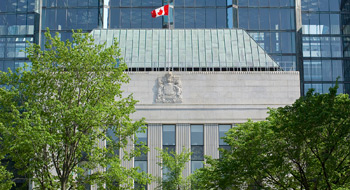

Investors should brace for another rate cut from the Bank of Canada.
BoC Governor Poloz has hinted he’s ready to make a move. In a December policy update, he dropped the Bank’s effective lower bound for its policy rate from +0.25% to -0.5%. So, in the event of “another major negative shock,” the Bank can “move [the] policy rate below zero to encourage spending.”
Since then, oil prices have weakened further while manufacturing is still in the doldrums. Plus, the Bank’s latest Business Outlook Survey was bleak. Not only are surveyed businesses as pessimistic as they were in 2009, but ripples from the oil shock have now spread to non-oil producing regions and sectors that are tied to the energy supply chain.
Read: BoC may cut rates again by mid-year: experts
Investors should be concerned. Last year’s oil weakness began in the summer, which gave the Bank ample time to decide to cut rates—and it made the right call. This time, the BoC’s only had a few weeks to consider the impact of $30 oil, so a third rate cut would be even more reactive and would only serve to bring us closer to 0% rates.
There’d be little payoff to such a move. Prab Sagoo, associate director at Nasdaq Advisory Service, notes, “Rates are already so low, while consumer debt is high. When Poloz cut from 0.75% to 0.5%, the movement wasn’t very effective because few changes were made to banks’ lending. Banks were already under pressure, and a further cut could weigh on profit margins” if banks felt compelled to pass those rates through to consumers.
Read: Central banks running out of options
Still, Poloz’s early January speech about U.S. monetary policy repeatedly stressed the BoC will run an independent policy “anchored by [its] inflation target.” Since then, inflation and growth expectations have both fallen. Also, he hammered home that the Bank isn’t afraid to do what it takes to stabilize the economy.
Most economists are predicting the BoC will ease rates. And, in a recent research note, CIBC World Markets economist Avery Shenfeld notes markets have also priced in more than one cut before mid-2016. Such predictions will mitigate the shock.
If Poloz stands pat, we can be sure of one thing: the Bank will remain dovish, and depress the loonie in hopes the so far elusive pick-up in exports and manufacturing will materialize. It also wants to keep credit cheap and hold off a bond sell-off.
When the Bank releases its January MPR, look for further explanation of the funding-for-credit program that was mentioned in a December BoC report. That program would allow the BoC to provide credit to significant markets, such as the energy sector. But, Sagoo says, it “would be used sparingly to stop further weakness and stabilize business sentiment. It would be a short-term measure that could be used from six months to a year.”
Poloz is in a tough spot, but has two choices: he can reactively lower rates with little effect, or can start 2016 by properly weighing how best to leverage policy tools to support the economy.
This article was originally published on Benefits Canada‘s companion site, Advisor.ca
